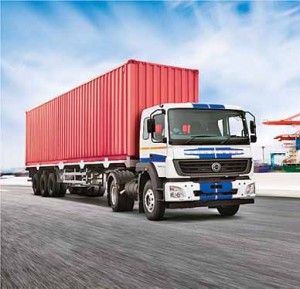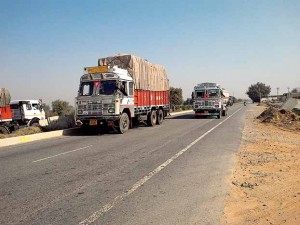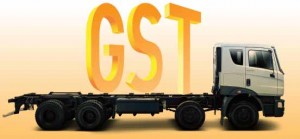Heavy commercial vehicles seem set to gain from GST.
Story by:
Bhushan Mhapralkar
The presence of Tata Signa 4923.S prime mover on Indian highways is growing. It is reflective of the growth of value trucks that are modern, safe and comfortable. The Signa 4923.S is however not the only one. In 2017, the HCV segment saw many new introductions. Hinting at a shift towards higher tonnage, new HCVs hit the road. Some of these were the MAN 49.300 Evo 6×4 prime mover, the Eicher Pro 8040 6×4 prime mover, the BharatBenz 4928T 6×4 prime mover, BharatBenz 4023T 4×2 prime mover, Eicher Pro 6040 4×2 prime mover, and the Eicher Pro 5035 4×2 prime mover. The list of new rigid HCVs that were introduced in 2017 is no less significant. In the 2017 calendar year, 321,319 M&HCVs were sold according to the Society of Automobile Manufacturers (SIAM). The least sales were recorded in April 2017. A mere 10,602 M&HCVs were sold. If the effect of demonetisation lingered, the migration to BSIV happened in April 2017. Almost a month later, Goods and Services Tax (GST) was implemented.
The GST effect
The immediate effect of GST was the abolition of border checks. It brought good news to long-haul transport operators. They could look at clocking better turn around times. As businesses tried to figure out new ways of paying taxes and doing paperwork, cargo deliveries dwindled. Despite the ability to clock better turnaround time, many fleet operators with left with much less to carry. The informal part of the transport industry went into a tizzy. The task of added paperwork would need to be looked at. The ones that figured out a way to fit into the GST framework stayed in business. They came to be a part of the organised trade. Its been six months after GST was implemented. The tax reform is putting CVs in the fast lane of tonnage growth. HCVs especially. The changes in the logistics industry driven by the GST will keep demand for large (>25 tonne) HCVs buoyant, it is said. Their tonnage growth is expected to be at 10 per cent over the next two-to-three years compared to three-to-four per cent growth foreseen for their lighter counterparts (<25 tonne).
The tonnage growth or shift could be tied to the logistical shift taking place. Logistics hubs (regional warehouses) are getting larger. They are claimed to increase average payloads in a scenario where hubs cater to ‘spokes’ (local warehouses). Drawing attention to the fact that large HCVs are comprising of more than 50 per cent of all CVs sold by tonnage (and not in terms of sales volumes), industry sources opine that unlike the environment before GST, when central state tax was levied if the state in which the final sale happened was different from where the warehousing or manufacturing happened, the need to have local warehouses or smaller warehouses is almost nil. They state that large companies typically maintained a warehouse in almost every state in order to achieve tax efficiency. The current situation dictates that large warehouses are the order of business. They cite examples of e-commerce players and 3PL companies. The movement towards larger warehouses, the location of which is driven by logistical advantages rather than tax concerns is said to be a prime reason behind tonnage growth.
Re-designing supply chain structure
The demand for HCVs as a primary tool to effect a tonnage shift is also happening on the basis of many companies re-designing their supply chain structures. The re-designing of supply chains would reduce the number of warehouses by up to 40 per cent. It would shrink their number from over 30 to about 18 in the next few years. The other factor that is driving a tonnage shift is the stricter implementation of norms that deter overloading. Most long-haul operators are already operating their trucks at rated payload. If an amount of overloading does happen at the level of operators, which ply within the state, a set of new norms that the ministry of road transport is claimed to be engineering will soon put such practices to rest. Most of these operators are said to be operating with the connivance of the regional authorities. If the coming up of flying squads at state borders that insist upon physically checking each truck is risking doing away the quick turnaround times and overall efficiency, the stricter adherence to anti-overloading norms is having a positive effect on fuel efficiency. The ability of truckers to achieve better fuel efficiency is also a reason that is influencing a shift to higher-tonnage CVs. Since fuel costs amount to 50 per cent of the operating costs, the positive shift in fuel efficiency means operating costs per tonne are lower for larger vehicles at high utilisation levels.
Better fuel efficiency may also lead to lower fixed costs, the availability of new technologies like different driving modes (dual torque)and tag axles on heavy trucks influencing a shift. Over the last three years, almost all the HCVs that have found their way to the market offer such technologies and more. Also contributing the shift to heavier trucks is the rising traction of large, integrated logistics players. In the first eight months of this fiscal, large HCVs with gross vehicle weight (GVW) over 25 tonne saw growth of more than 45 per cent in tonnage. Their lighter counterparts, trucks with less than 25-tonnes GVW, posted a decline of more than 10 per cent. Expressed Binaifer Jehani, Director, Crisil Research, “As hubs get bigger, and thicker for a few industries, preference will shift to much higher-tonnage HCVs (towards 37-tonne multi-axle vehicles and higher-tonnage tractor-trailers). Also, new product offerings by OEMs in the higher tonnage intermediate commercial vehicles (ICVs) segment will continue to gain traction along the spoke routes.”
The shift in tonnage as far as HCVs are concerned is likely to falter where warehousing decisions are driven by a need to be closer to dealers. In sectors like pharmaceuticals for example. The introduction of new models would be necessary to fill the gaps that emerge, necessitating higher investment in product development. CV OEMs like Eicher and Tata Motors are already said to be developing 10×5 rigid haulage trucks with a GVW of over 40-tonnes. These trucks, industry sources mention, will have twin steerable front axles and more than one tag axle to facilitate maximum efficiency.
The way the removal of bottlenecks in the form of checkpoints and their subsequent replacement with flying squads on some states plays out over time will determine if the implementation of GST has really upped the operational efficiency of operators. If it will reduce the fleet size requirements. The coming of the e-way bill should ideally address the issue of flying squads, which are claimed to be under the control of the states. The restructuring of fuels under GST is also being opposed by states. International crude prices are rising. Rising fuel prices are certain to exert pressure on operating costs. While this would create an opportunity for heavier, more efficient CVs, the demand for bringing fuels under the GST net will also increase. If brought under GST, the demand for HCVs will rise even further. Improving industrial activity and rising focus on infrastructure and rural economy are expected to partly offset downside pressures on CV sales. Players with stronger product profiles in ICVs and HCVs will stand to benefit. This will support their credit profiles it is looking like.Those that are unable to adapt to the shift towards higher tonnage will experience stress.





























